Sinead Williamson
Carnegie Mellon University
BED-LLM: Intelligent Information Gathering with LLMs and Bayesian Experimental Design
Aug 28, 2025Abstract:We propose a general-purpose approach for improving the ability of Large Language Models (LLMs) to intelligently and adaptively gather information from a user or other external source using the framework of sequential Bayesian experimental design (BED). This enables LLMs to act as effective multi-turn conversational agents and interactively interface with external environments. Our approach, which we call BED-LLM (Bayesian Experimental Design with Large Language Models), is based on iteratively choosing questions or queries that maximize the expected information gain (EIG) about the task of interest given the responses gathered previously. We show how this EIG can be formulated in a principled way using a probabilistic model derived from the LLM's belief distribution and provide detailed insights into key decisions in its construction. Further key to the success of BED-LLM are a number of specific innovations, such as a carefully designed estimator for the EIG, not solely relying on in-context updates for conditioning on previous responses, and a targeted strategy for proposing candidate queries. We find that BED-LLM achieves substantial gains in performance across a wide range of tests based on the 20-questions game and using the LLM to actively infer user preferences, compared to direct prompting of the LLM and other adaptive design strategies.
Self-reflective Uncertainties: Do LLMs Know Their Internal Answer Distribution?
May 26, 2025Abstract:To reveal when a large language model (LLM) is uncertain about a response, uncertainty quantification commonly produces percentage numbers along with the output. But is this all we can do? We argue that in the output space of LLMs, the space of strings, exist strings expressive enough to summarize the distribution over output strings the LLM deems possible. We lay a foundation for this new avenue of uncertainty explication and present SelfReflect, a theoretically-motivated metric to assess how faithfully a string summarizes an LLM's internal answer distribution. We show that SelfReflect is able to discriminate even subtle differences of candidate summary strings and that it aligns with human judgement, outperforming alternative metrics such as LLM judges and embedding comparisons. With SelfReflect, we investigate a number of self-summarization methods and find that even state-of-the-art reasoning models struggle to explicate their internal uncertainty. But we find that faithful summarizations can be generated by sampling and summarizing. Our metric enables future works towards this universal form of LLM uncertainties.
Revisiting Uncertainty Quantification Evaluation in Language Models: Spurious Interactions with Response Length Bias Results
Apr 18, 2025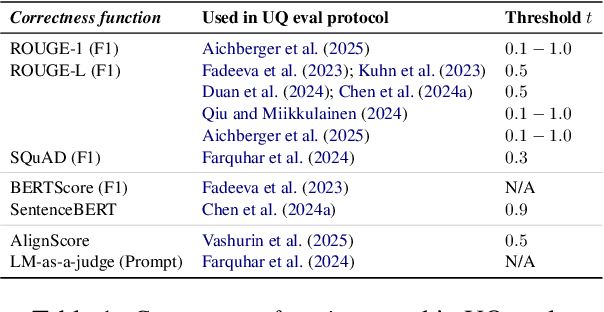

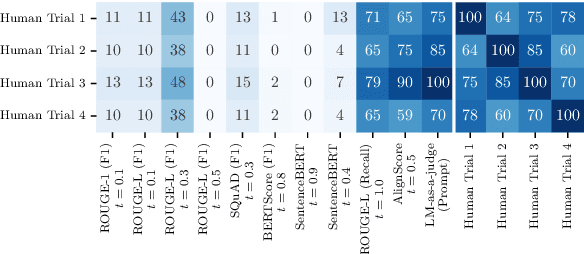
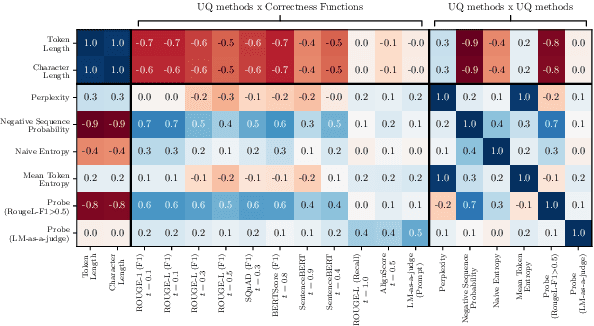
Abstract:Uncertainty Quantification (UQ) in Language Models (LMs) is crucial for improving their safety and reliability. Evaluations often use performance metrics like AUROC to assess how well UQ methods (e.g., negative sequence probabilities) correlate with task correctness functions (e.g., ROUGE-L). In this paper, we show that commonly used correctness functions bias UQ evaluations by inflating the performance of certain UQ methods. We evaluate 7 correctness functions -- from lexical-based and embedding-based metrics to LLM-as-a-judge approaches -- across 4 datasets x 4 models x 6 UQ methods. Our analysis reveals that length biases in the errors of these correctness functions distort UQ assessments by interacting with length biases in UQ methods. We identify LLM-as-a-judge approaches as among the least length-biased choices and hence a potential solution to mitigate these biases.
Steering into New Embedding Spaces: Analyzing Cross-Lingual Alignment Induced by Model Interventions in Multilingual Language Models
Feb 21, 2025Abstract:Aligned representations across languages is a desired property in multilingual large language models (mLLMs), as alignment can improve performance in cross-lingual tasks. Typically alignment requires fine-tuning a model, which is computationally expensive, and sizable language data, which often may not be available. A data-efficient alternative to fine-tuning is model interventions -- a method for manipulating model activations to steer generation into the desired direction. We analyze the effect of a popular intervention (finding experts) on the alignment of cross-lingual representations in mLLMs. We identify the neurons to manipulate for a given language and introspect the embedding space of mLLMs pre- and post-manipulation. We show that modifying the mLLM's activations changes its embedding space such that cross-lingual alignment is enhanced. Further, we show that the changes to the embedding space translate into improved downstream performance on retrieval tasks, with up to 2x improvements in top-1 accuracy on cross-lingual retrieval.
Analyze the Neurons, not the Embeddings: Understanding When and Where LLM Representations Align with Humans
Feb 20, 2025Abstract:Modern large language models (LLMs) achieve impressive performance on some tasks, while exhibiting distinctly non-human-like behaviors on others. This raises the question of how well the LLM's learned representations align with human representations. In this work, we introduce a novel approach to the study of representation alignment: we adopt a method from research on activation steering to identify neurons responsible for specific concepts (e.g., 'cat') and then analyze the corresponding activation patterns. Our findings reveal that LLM representations closely align with human representations inferred from behavioral data. Notably, this alignment surpasses that of word embeddings, which have been center stage in prior work on human and model alignment. Additionally, our approach enables a more granular view of how LLMs represent concepts. Specifically, we show that LLMs organize concepts in a way that reflects hierarchical relationships interpretable to humans (e.g., 'animal'-'dog').
Posterior Uncertainty Quantification in Neural Networks using Data Augmentation
Mar 18, 2024



Abstract:In this paper, we approach the problem of uncertainty quantification in deep learning through a predictive framework, which captures uncertainty in model parameters by specifying our assumptions about the predictive distribution of unseen future data. Under this view, we show that deep ensembling (Lakshminarayanan et al., 2017) is a fundamentally mis-specified model class, since it assumes that future data are supported on existing observations only -- a situation rarely encountered in practice. To address this limitation, we propose MixupMP, a method that constructs a more realistic predictive distribution using popular data augmentation techniques. MixupMP operates as a drop-in replacement for deep ensembles, where each ensemble member is trained on a random simulation from this predictive distribution. Grounded in the recently-proposed framework of Martingale posteriors (Fong et al., 2023), MixupMP returns samples from an implicitly defined Bayesian posterior. Our empirical analysis showcases that MixupMP achieves superior predictive performance and uncertainty quantification on various image classification datasets, when compared with existing Bayesian and non-Bayesian approaches.
Bootstrap Your Own Variance
Dec 06, 2023Abstract:Understanding model uncertainty is important for many applications. We propose Bootstrap Your Own Variance (BYOV), combining Bootstrap Your Own Latent (BYOL), a negative-free Self-Supervised Learning (SSL) algorithm, with Bayes by Backprop (BBB), a Bayesian method for estimating model posteriors. We find that the learned predictive std of BYOV vs. a supervised BBB model is well captured by a Gaussian distribution, providing preliminary evidence that the learned parameter posterior is useful for label free uncertainty estimation. BYOV improves upon the deterministic BYOL baseline (+2.83% test ECE, +1.03% test Brier) and presents better calibration and reliability when tested with various augmentations (eg: +2.4% test ECE, +1.2% test Brier for Salt & Pepper noise).
SMGRL: A Scalable Multi-resolution Graph Representation Learning Framework
Jan 29, 2022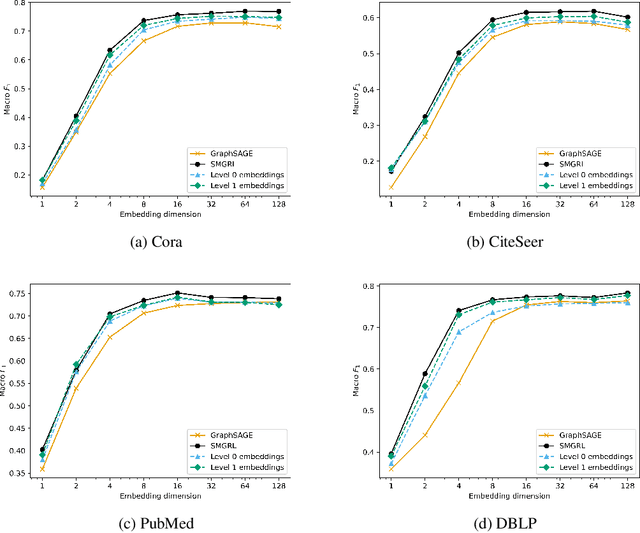
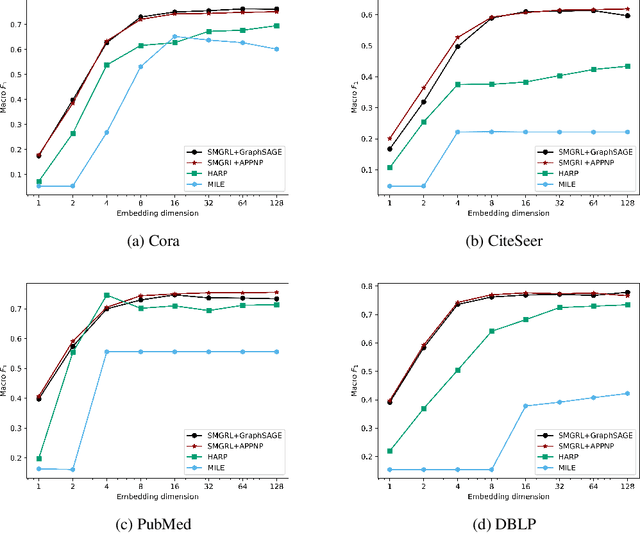

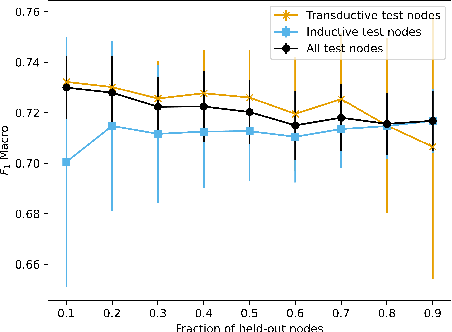
Abstract:Graph convolutional networks (GCNs) allow us to learn topologically-aware node embeddings, which can be useful for classification or link prediction. However, by construction, they lack positional awareness and are unable to capture long-range dependencies without adding additional layers -- which in turn leads to over-smoothing and increased time and space complexity. Further, the complex dependencies between nodes make mini-batching challenging, limiting their applicability to large graphs. This paper proposes a Scalable Multi-resolution Graph Representation Learning (SMGRL) framework that enables us to learn multi-resolution node embeddings efficiently. Our framework is model-agnostic and can be applied to any existing GCN model. We dramatically reduce training costs by training only on a reduced-dimension coarsening of the original graph, then exploit self-similarity to apply the resulting algorithm at multiple resolutions. Inference of these multi-resolution embeddings can be distributed across multiple machines to reduce computational and memory requirements further. The resulting multi-resolution embeddings can be aggregated to yield high-quality node embeddings that capture both long- and short-range dependencies between nodes. Our experiments show that this leads to improved classification accuracy, without incurring high computational costs.
Differentially Private Median Forests for Regression and Classification
Jun 15, 2020



Abstract:Random forests are a popular method for classification and regression due to their versatility. However, this flexibility can come at the cost of user privacy, since training random forests requires multiple data queries, often on small, identifiable subsets of the training data. Differentially private approaches based on extremely random trees reduce the number of queries, but can lead to low-occupancy leaf nodes which require the addition of large amounts of noise. In this paper, we propose DiPriMe forests, a novel tree-based ensemble method for regression and classification problems, that ensures differential privacy while maintaining high utility. We construct trees based on a privatized version of the median value of attributes, obtained via the exponential mechanism. The use of the noisy median encourages balanced leaf nodes, ensuring that the noise added to the parameter estimate at each leaf is not overly large. The resulting algorithm, which is appropriate for real or categorical covariates, exhibits high utility while ensuring differential privacy.
Federating Recommendations Using Differentially Private Prototypes
Mar 01, 2020



Abstract:Machine learning methods allow us to make recommendations to users in applications across fields including entertainment, dating, and commerce, by exploiting similarities in users' interaction patterns. However, in domains that demand protection of personally sensitive data, such as medicine or banking, how can we learn such a model without accessing the sensitive data, and without inadvertently leaking private information? We propose a new federated approach to learning global and local private models for recommendation without collecting raw data, user statistics, or information about personal preferences. Our method produces a set of prototypes that allows us to infer global behavioral patterns, while providing differential privacy guarantees for users in any database of the system. By requiring only two rounds of communication, we both reduce the communication costs and avoid the excessive privacy loss associated with iterative procedures. We test our framework on synthetic data as well as real federated medical data and Movielens ratings data. We show local adaptation of the global model allows our method to outperform centralized matrix-factorization-based recommender system models, both in terms of accuracy of matrix reconstruction and in terms of relevance of the recommendations, while maintaining provable privacy guarantees. We also show that our method is more robust and is characterized by smaller variance than individual models learned by independent entities.
 Add to Chrome
Add to Chrome Add to Firefox
Add to Firefox Add to Edge
Add to Edge